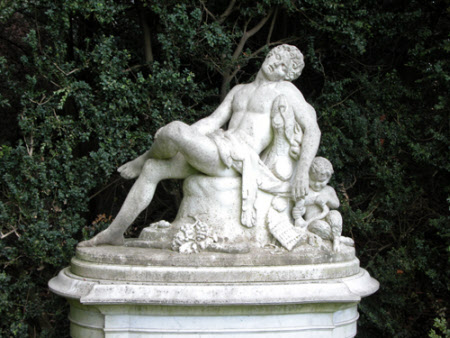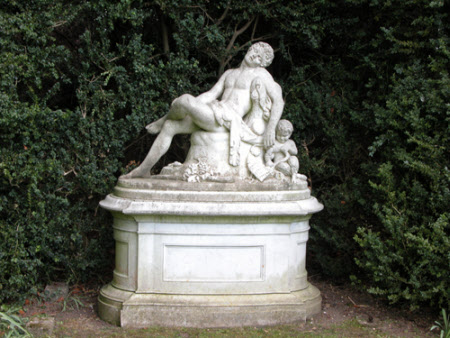The Sleeping Faun
Harriet Goodhue Hosmer (Massachusetts 1830 - 1908)
Category
Art / Sculpture
Date
circa 1865
Materials
Marble
Measurements
166 x 146 x 67 cm
Place of origin
Rome
Order this imageCollection
Anglesey Abbey, Cambridgeshire
NT 516616
Summary
Marble, The Sleeping Faun, Harriet Goodhue Hosmer (Massachusetts 1830 - 1908), after 1865, inscribed ‘THE SLEEPING FAUN’ on front of base and ‘H HOSMER FECIT ROMÆ’ on back of base. Mounted on a moulded marble base and pedestal. After a night of merrymaking in the forest a faun, represented as a beautiful youth with pointed ears, dozes against a tree stump, a tiger skin draped over his lap. An infant satyr crouches behind the stump and mischievously ties the tail of the tiger’s skin to the trunk so that the faun will unwittingly be denuded when he awakens. A salamander slithers over the base of the tree stump towards a bunch of grapes which symbolise the faun’s drunkenness. His panpipes and staff are discarded on the mossy forest floor.
Full description
The Sleeping Faun is a celebrated work by the American neoclassical sculptor Harriet Godue Hosmer, carved at her studio in Rome and first shown at the Dublin Exhibition of 1865. The Times called it ‘one of the finest’ works to be seen there, intrigued that amongst all the sculpture ‘contributed by the natives of lands in which the fine arts were naturalized thousands of years ago’, the best was ‘the production of an American’ (quoted in Crow 1912, p. 210). Hosmer won popular acclaim for the group's playful characterisation, the beautiful but inebriated faun completely unaware of the joke being played at his expense by the baby satyr, and was praised by connoisseurs for embodying a grace worthy of antique prototypes. Were the sculpture ‘dug out of the ruins of the Forum Romanum’, wrote the Art Journal, it ‘might be held up in public estimation as a fit companion for the Apollo Belvedere' (Art Journal, 27, November 1865, p. 346). Despite Hosmer’s firm intention to send the Sleeping Faun to America, it was bought almost immediately by the brewing magnate and founder of the Dublin Exhibition, Sir Benjamin Guinness, and kept at Guinness’ former residence, Iveagh House, where it remains today. Two years after its celebrated debut in Ireland, Hosmer exhibited another Sleeping Faun at the 1867 Exposition Universelle, Paris, where it received renewed praise. She was the only American woman to exhibit there, publicly refusing the Italian government’s offer to pay for shipping and footing the bill herself so that she would be free to display the statue amongst American – not Roman – exhibits. Hosmer’s thriving workshop went on to produce several copies of the Sleeping Faun in life-size and reduced two-thirds-life-size formats, and, in 1867, to carve the Waking Faun, a far less successful pendant now lost. Replicas of the former include those at the Museum of Fine Arts, Boston (inv.no. 12.709; formerly owned by Hosmer’s friend and biographer Cornelia Crow Carr), the Cleveland Museum of Art (inv.no. 1997.15; ordered by Edward VII); the High Museum of Art, Atlanta (inv.no. 2010.61); the Manchester Public Library, Manchester-by-the-Sea (bought by T.J. Coolidge in Rome in 1869), and the Walker Art Gallery, Liverpool. The replica ordered by Hosmer’s patron and lover Lady Louisa Ashburton is presumably that at Castle Ashby, seat of the marquisate of Northampton into which Lady Ashburton’s daughter Mary married. The copy at Anglesey Abbey was bought by Lord Fairhaven in March 1959 from the architectural salvage and statuary dealer Bert Crowther whose receipts occasionally reveal the provenance of acquisitions. The paperwork for this Sleeping Faun, however, shows only the price paid: £180, around £3,800 in today’s money. Two further replicas were most recently with Abell, Los Angeles, and Sotheby’s, London, in 2018. Harriet Hosmer was born in 1830 in Watertown, Massachusetts, the only surviving daughter of Hiram Hosmer, a doctor, who had lost his wife and three other children to tuberculosis. She received a progressive education and was encouraged by her father to travel and pursue sculpture after showing an aptitude for modelling at an early age. Hosmer was prohibited from studying the life model at art academies, a privilege then only extended to male students, so instead enrolled at Missouri Medical College to take lessons in anatomy before departing for Rome in 1852. There she became the pupil of the Welsh neoclassical sculptor John Gibson (1790-1866), himself a pupil of Canova and Thorvaldsen, and was finally able to model from life. With access to a wealth of classical sculpture, marble from the abundant quarries of Carrara and Seravezza, and skilled craftsmen to support her work, Hosmer spent seven years training in Rome before opening her own studio in 1860. Ancient sculpture, particularly that of the 4th century Attic master Praxiteles, proved to be a 'true and lasting fount of inspiration’ for the sculptor, the Faun’s marble flesh, for example, burnished to a sensuous silky finish typical of the Praxitelean school, his body sinuous and perfectly proportioned like a classical Greek nude (quoted Jan Seidler Ramirez in Greenthal, Kozol and Ramirez 1986, no. 52, p. 163). Antique prototypes such as the Sleeping Faun of the Villa Papyri, Herculaneum, a 1st century BC-1st century AD bronze cast in the tradition of the far more explicit Barberini type, have been identified as possible influences on Hosmer's figure, as has her tutor John Gibson's Sleeping Shepherd, his first original marble carved under the supervision of Canova in 1824 (Chatsworth; the model of 1818 at the Royal Academy of Art, London, object no. 03/1919; a version of 1834 at The Walker, Liverpool). Alice Rylance-Watson 2019
Provenance
Purchased by Urban Huttleston Rogers Broughton, 1st Lord Fairhaven (1896-1966) from Bert Crowther of Syon Lodge, 23 March 1959, £180; bequeathed to the National Trust by Lord Fairhaven in 1966 with the house and the rest of the contents.
Credit line
Anglesey Abbey, The Fairhaven Collection (The National Trust)
Marks and inscriptions
Front of base: THE SLEEPING FAUN Back of base, signed: H HOSMER FECIT ROMÆ
Makers and roles
Harriet Goodhue Hosmer (Massachusetts 1830 - 1908), sculptor
References
Carr 1912: Cornelia Carr, Harriet Hosmer: Letters and Memories, New York 1912 Greenthal, Kozol and Ramirez 1986: Kathryn Greenthal, Paula M. Kozol, Jan Seidler Ramirez, American Figurative Sculpture in the Museum of Fine Arts, Boston, Boston, MA,1986, no. 52, pp. 163-66. Jaffe 1989: Irma B. Jaffe, The Italian Presence in American Art, 1760-1860, Fordham University Press, New York, 1989, Andrea Mariani, 'Sleeping and Waking Fauns, Harriet Godue Hosmer's Experience of Italy, 1852-1870', pp. 66-81. Tolles 2003: Thayer Tolles (ed.), Perspectives on American Sculpture before 1925, Metropolitan Museum of Art symposia, New York 2003, Melissa Dabakis, 'The Eccentric Life of a "Perfectly Emancipated Female": Harriet Hosmer's early years in Rome', pp. 24-43. Roper 1964: Lanning Roper, The Gardens of Anglesey Abbey, Cambridgeshire. The Home of Lord Fairhaven, London 1964, p. 60, pl. 36. Dabakis 2014: Melissa Dabakis, A Sisterhood of Sculptors: American Artists in Nineteenth-Century Rome, Penn State Press, Pennsylvania, 2014 Christie, Manson & Woods 1971: The National Trust, Anglesey Abbey, Cambridge. Inventory: Furniture, Textiles, Porcelain, Bronzes, Sculpture and Garden Ornaments’, 1971, p. 159. Conroy, Rachel, Women Artists and Designers at the National Trust, 2025, pp. 128-9

